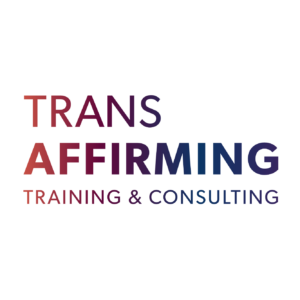Who am I to be doing this work? Is this appropriate work for an ally to be doing? How do I know if I am representing this community in the best possible way? How can I hold myself accountable to the communities I am advocating for?
These are important questions to for every ally (across all identities and demographics) to consider when deciding whether or not to facilitate a training about a topic outside of their own identity and experience. The best ally work is always work that is in progress. Regardless of our identities, we can always do a better job at being better allies/advocates. As facilitators we have a particular obligation to make sure that we are doing the very best that we can do, so that our trainings maximize the potential for positive social change.  In the context of transgender-related trainings, the end goal is to contribute toward a world that is safe and affirming for transgender people.
Allies are an essential component of creating this social change. Allies can be fierce and amazing advocates in spaces where it is not safe for transgender people to speak up or where transgender people are not safely able to be out. When facilitating with some audiences, allies can be perceived as less threatening or intimidating for those who are anxious about being offensive or revealing ignorance, which can increase participants’ willingness to engage/learn. It is also critical that allies take on the responsibility for raising awareness, creating change and increasing accountability so that the burden of change does not fall solely on transgender people.
That said, it is also important for cisgender allies to carefully consider the training work that they do, how that work is informed, and if they are taking opportunities away from transgender people and communities. There is a fine balance between moving up as an ally/advocate, and being a privileged person who takes up space. It can be really hard to figure out how to navigate this divide in a thoughtful and self-aware manner – particularly without asking transgender people to make that determination on your behalf.
There is no rubric that can be applied in all situations, but here we offer six questions to help cisgender allies engage in an intentional process. These questions may be helpful as a starting point when considering whether or not to facilitate a particular transgender training, transgender trainings as a whole, or how to be a better ally/advocate in the process:
- How did you come by your transgender knowledge, expertise and training materials? Â Is that expertise a direct match for the training being requested? Are your materials informed by transgender people and communities?
- If what you are saying in your presentations is something you have been saying for more than two years, what are you doing to update your knowledge?
- Which parts of the transgender communities do you have the most contact with and what are you doing to connect with and represent other parts of transgender communities? Â
- In what ways do you incorporate intersectionality into your trainings, particularly as it relates to representing racial and economic disparities and their impacts on transgender people and communities?
- Are there transgender people in your area/community/profession who would want to do the training instead or who might be a better match? Have they been asked? Have you helped make that connection? Have you passed paying and/or high profile work on to transgender people?
- If you are profiting from leading transgender trainings, are you giving a portion of the proceeds back to transgender organizations that are led by and serve transgender people?
Edited to add: Â Our colleague Alex S. Morgan offered the following additional question for folks to consider:
7. Based on the context, setting and content of the training, would this audience be best served by having a co-facilitator who is transgender?
These questions can also be for ally work in other communities by changing the transgender-specific parts to parts that are specific to other communities.  These questions are a starting point and not an exhaustive list.  What other questions do you think should be added to this list?
Interested in additional tools to assess your areas of strength and growth as a transgender trainer?  Check out the Facilitator Self-Assessment and Recommended Reading & Resources sections of The Teaching Transgender Toolkit: A Facilitator’s Guide to Increasing Knowledge, Reducing Prejudice & Building Skills. For sale at www.teachingtransgender.com.Â
